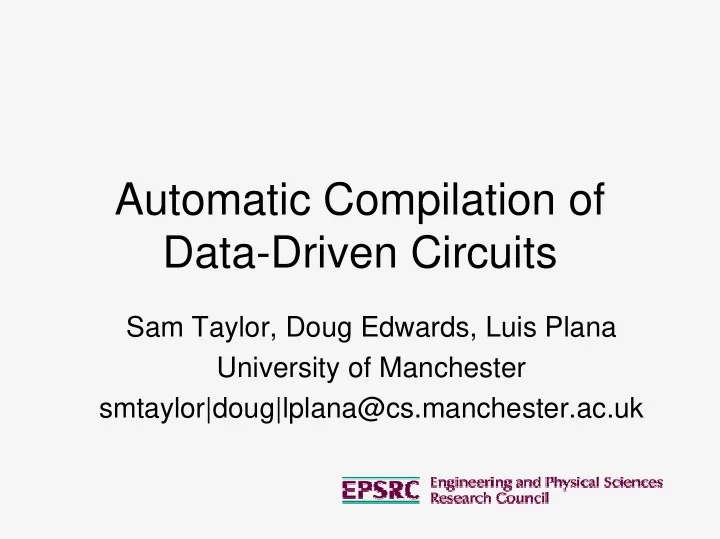

Automatic Compilation of Data-Driven Circuits Sam Taylor, Doug Edwards, Luis Plana University of Manchester smtaylor|doug|lplana@cs.manchester.ac.uk
Summary • Handshake Circuit paradigm is nice • Control-driven style is flexible but slow • Data-driven approaches provide better performance • Combine data-driven approach with handshake circuit paradigm • An alternative option for designers?
Balsa Design Flow Design refinement (manual process) Balsa code re−use Balsa compiler Handshake Circuit Behavioural simulation Behaviour (Breeze netlist) (breeze−sim) balsa−netlist Gate−level simulation Gate−level netlist Function Commercial layout tools Layout simulation Layout Timing
Handshake Circuits • Intermediate representation independent of implementation styles • Networks of small components communicating by handshakes • Each component (relatively) straightforward to implement in isolation • Successful method of implementing large circuits • Syntax-directed translation
Balsa one-place buffer variable v activate Sync (activation) channel loop Data channel i -> v; Request # Acknowledge o <- v end ; i O V
Advantages of control-driven structure • Passive-ported variable is very flexible. Read and write in any order like a sequential programming language • Familiar control structures - loops etc. • Low power – nothing gets done that does not need doing.
Why does the structure of Balsa circuits make them slow? • Control-driven compilation • Monolithic control • Lots of sequencers • Frequent synchronisation between control and data • Control Overhead. Data is always waiting for control. • Data-driven style attempts to avoid all of these problems
activate Control-driven ; structure Input control Input control Input control Write Write @ control control A FV Output Output conditional conditional control control processing processing V0 O output output processing processing V1
Three main issues • All inputs are synchronised • Sequential activation of ‘reads’ and ‘writes’ • Data processing operations occur sequentially after control instead of in parallel So look at the main structures of Balsa handshake circuits and replace with data- driven alternatives
Input control activate activate a a FV Processing Processing b b FV dup
Localised sequencing input i loop output v i -> v; during o <- v v <- i end end # input v output o during ; o <- v end i o i o V V
Data processing activate a, b -> then o1 <- a + b || o2 <- b end | | a FV o1 + b FV o2
Data processing input a, b output o1, o2 during o1 <- a + b o2 <- b a o1 + end b o2 dup
activate.req activate.ack C a.req a.ack o1.req T C T o1.ack b.req b.ack o2.req T T C o2.ack a.req a.ack o1.req C b.req T o1.ack o2.req T b.ack C o2.ack
Data-driven structure Write Write @ control control A Output Output conditional conditional control control processing processing V0 O output output processing processing V1
Code a, b -> then input a, b o1 <- a + b output o1, o2 || o2 <- b during end o1 <- a + b o2 <- b end Each block in data-driven code is basically the description of a pipeline stage.
Balsa vs. data-driven philosophy • Collect all inputs • List of operations • Decide what • Do all of these operation to do operations as soon as you can (speculate) • Do the operation • Don't synchronise • Release the inputs until you absolutely must • Throw away the results of operations you don't need
Design Flow Design refinement (manual process) Data−driven code Balsa code Data−driven re−use Balsa compiler compiler Handshake Circuit Behavioural simulation Behaviour (Breeze netlist) (breeze−sim) new component behaviour descriptions new component balsa−netlist gate−level descriptions Gate−level simulation Gate−level netlist Function Commercial layout tools Layout simulation Layout Timing
nanoSpa • Cut-down ARM processor • Balsa design intended for maximum performance • Data-driven equivalent with same architecture and handshake component implementation style (try to look just at improvement from structure) • Data-driven bundled data and dual-rail implementations both about 1.5x improvement over Balsa version
Syntax-directed translation? • To use syntax-directed translation I restricted the input language so that one could only write what I wanted to produce! • This is probably fine for an experienced designer – it gives them what they want. • Probably not fine for others – they don’t know how to think ‘asynchronous’. • But the same thinking is needed to write fast Balsa.
Conclusion • The structure of control-driven handshake circuits is familiar and flexible but contributes to their poor performance • Data-driven circuits perform better but are not as familiar and flexible • Both styles can be combined in the same flow • Future work could include automatic transformation from control to data-driven or at least more structures to assist data-driven design
activate.req activate.ack C a.req T C T o1.ack C b.req T T C o2.ack C CD CD 0 0 a.ack adder o1.req 0 0 b.ack o2.req
a.ack o1.ack T T b.ack o2.ack C CD a.req adder o1.req b.req o2.req
@ | Regular decode | to execute | from fetch @ | LDM/STM Iterative decode | | from fetch Regular decode | to execute | ctrl | LDM/STM decode |
control r0 control r1 Write data Write r0 Control Control r3 Write r4 r1 Control data Write r2 Control Write r3 Control
| |
Recommend
More recommend